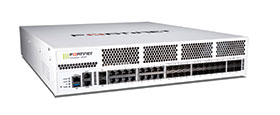

Fortinet unveiled the FortiGat 1800F next-generation firewall (NGFW) powered by NP7, the company’s seventh generation network processor, to enable today’s largest enterprises to achieve true internal segmentation as well as scale, performance, detection and enforcement capabilities.
Flat networks fall flat when attacked
Digital innovation is disrupting enterprise organisations, creating new services and business opportunities while also causing increased risk across all industries. Explosive adoption of IoT and mobile devices, as well as applications and services from multiple clouds, are pushing the attack surface beyond the traditional network boundaries. An expanding and fragmented attack surface is undermining the ability of network security leaders to maintain network performance, security, reliability and availability.
In today’s data centres, many enterprise architectures have been built on a high-performance routing and switching infrastructure without integrating security. Many have turned to internal segmentation as a way to regain control over their burgeoning networks and to improve visibility and security.
Internal segmentation requires extreme performance
A new challenge has emerged for enterprises trying to successfully segment their network: security performance. Today’s enterprises face unprecedented performance demands on their infrastructure that often cannot be matched by existing security solutions. For a majority of enterprises, traditional security appliances that are built with off-the-shelf CPUs and hardware to process security traffic have become an infrastructure bottleneck, resulting in degraded user and application experience. Simply put, yesterday’s security performance is no longer enough to secure and enable enterprises at the pace of today’s business innovation.
To meet the extraordinary demands of data centre security and enable a Security-Driven Networking approach, Fortinet is introducing the FortiGate 1800F NGFW.
Use cases and benefits
Fortinet’s FortiGate 1800F NGFW is engineered for large enterprises to quickly and securely drive digital innovation by offering capabilities to meet the huge capacity and performance demands of critical business operations such as:
• Managing internal security risks: Most firewalls simply cannot perform fast enough to enable internal segmentation. With multiple high speed 40G interfaces and the industry’s best threat protection performance with a Security Compute Rating of 3x, FortiGate 1800F enables enterprises to properly segment their network to manage internal security risks. Additionally, FortiGate 1800F intelligently adapts to segmented users, devices and applications – regardless of their location, whether on-premise or in multiple clouds – providing automated threat detection and enforcement.
• Accelerating the cloud on-ramp: IPsec encryption must be high performing to enable and accelerate the cloud on-ramp for organisations adopting multiple clouds for IaaS and SaaS services. FortiGate 1800F offers the highest Security Compute Rating of 14x for IPsec encryption when benchmarked against competitors, enabling the required speed, scale and availability organisations need when on-ramping to the cloud.
• Removing blind spots: With as much as 60% of encrypted traffic containing malware, SSL inspection performance has become critical to properly secure the network. FortiGate 1800F offers the industry’s highest SSL inspection performance with a Security Compute Rating of 20x, as well as support for the industry’s latest TLS 1.3 standard, to eliminate network blind spots by enabling full visibility of clear-text and encrypted network flows.
• Securing services across hybrid architectures: Traditional software-based security solutions have low performance and high latency, which increases time to service and provides a poor user experience. The FortiGate 1800F’s hardware-accelerated Virtual Extension LAN (VXLAN) feature enables massively scalable, adaptable internal segmentation and allows super-fast communication between enormously scaled services, such as compute, storage and applications that are co-hosted on physical and virtual platforms. This allows organisations that leverage a highly scalable virtual services architecture to launch services and applications in the most agile fashion possible to increase productivity and revenue opportunities.
• Enabling secure advanced research: Organisations often transition their research to AI and ML simulations to allow for faster discovery of their objectives. For example, pharmaceuticals can measure the effectiveness of new drugs or develop drugs faster with reduced risks and potentially with lower costs. AI/ML simulations require the transfer of huge datasets (e.g. 1 TB files), called an elephant flow, that today’s data centres struggle to securely transfer, bringing research and collaboration to a crawl. The performance capabilities of FortiGate 1800F allow research organisations to perform big data analysis and natural language processing at unprecedented speeds where a single elephant flow can reach up to 40 Gbps. Just as important, with FortiGate 1800F NGFWs, these elephant flows are secured using high-performance encryption to ensure privacy and compliance.
For more information, go to http://www.fortinet.com

© Technews Publishing (Pty) Ltd. | All Rights Reserved.